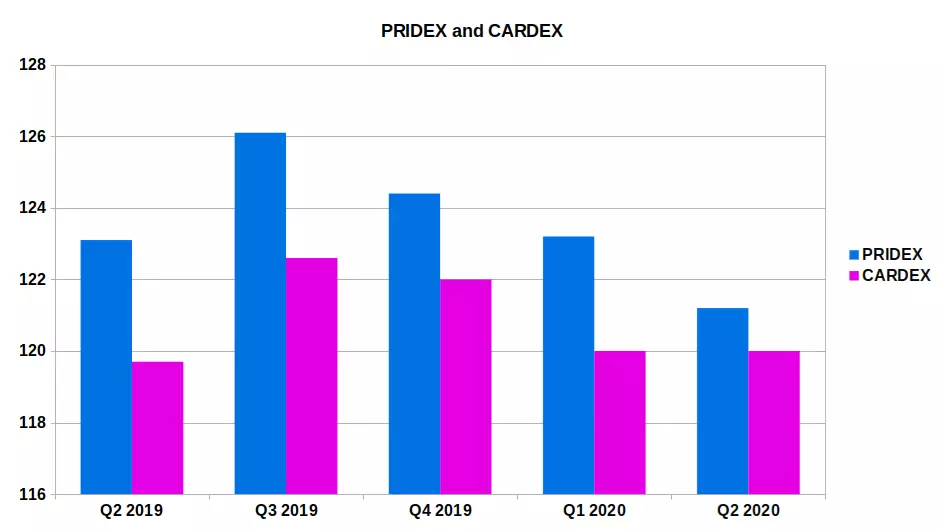Pridex and Cardex: How they empower print - The Noel D'Cunha Sunday Column
Predicting how much a printed sheet will cost is critical, but it can be complex. Data matters, and data can be optimised and shaped to set the price.
Pridex and Cardex are decision-making AIFMP-CRISIL indices.
In the Sunday Column, Sanjay Patel, the former president of BMPA, and incharge of the project explains its importance
02 Feb 2020 | By Noel D'Cunha
We have been hearing all the news of slowdown and facing its effects on the industry for some quarters now. At the same time printing and packaging industry has been battling with overcapacity, the rising input costs, and excessive pricing pressures by the competition that is trying to keep up with lowering print runs. What can offer some respite is a more rational, data-driven, and scientific tool to correctly and more predictively track trends of the input costs for the two prominent industry verticals of our industry – commercial printing and packaging.
“Despite tremendous efforts on our part a lot of us haven’t got our price increases from our clients, am I correct?” asks Faheem Agboatwala, former president of BMPA.
Why do we need these indices?
As business persons our motive is to increase our financial base, derive maximum profits, and achieve sustainable growth for our businesses. We often come across clients telling us about what price should we quote for our service. While negotiation is a part and parcel of B2B transactions, it is important to negotiate the quotes basis some factual and indisputable data. In order to have a healthy negotiation we need numbers, a scientifically developed data-set that would help us set and demand fair prices for our products and services. The AIFMP-CRISIL indices help printers understand the changes in the input costs of different components, such as raw material, finance, transportation, and many more, based on which we can offer a fair-price quote to the customer, and at the same time realise our business’ potential.
AIFMP-CRISIL Indices: a journey worth an introspect
Each time we conduct business with our clients and customers, we are actually ‘dealing’ with them. Most of the times, at the end of the day we are discontented and unhappy with our performance. A printer working among ten more printers, its competitors, is often suppressed with the fact that there is another printer who is offering a lesser cost for the same product or the service. The question is often posed, why should I pay you a higher cost for the same job when someone else is ready to deliver at a lower cost?
In India, despite the lower per-capita print consumption we have a lot diverse and larger print industry creating over capacity and putting immense competitive pressure on each business operating with the crowded industry. Why do we not come together as a community and justify our business and demand fair price? Why do we not charge prices basis some ethically correct measure? That is where the AIFMP-CRISIL indices come into the picture.
“Whenever and wherever we met, be it a regional association meeting or the national level meeting of AIFMP, the discussions among the printers revolved around sky-rocketing costs. The higher prices are also deteriorating the investment-to-return ratio; what we received in return earlier, we don’t receive now was the and is the primary complaint,” says Patel, past president of BMPA and the Project In-charge, who led the project to make the two indices a reality. The managing committee members of BMPA and AIFMP who are behind the origin of these indices went through a lot of brainstorming, discussions, and observed the typical costing patterns concerning the print industry. They also calculated and analysed the different input costs and calculated different weights for each one of them for two print verticals – commercial printing and packaging – considering how the input components play a role within the vertical, eventually deciding the price for the products and the services offered by the two verticals.
After careful calculations for each of the input cost component, the AIFMP-CRISIL team finally came up with two separate indices, the PRIDEX for commercial printing and CARDEX for packaging.
With the base value as 100 for the fiscal year 2013-2014, these indices were and are updated from quarter-to-quarter on the AIFMP-CRISIL indices’ page: https://tinyurl.com/yayqnp2k.The detailed methodology used at computing PRIDEX and CARDEX is readily available at https://tinyurl.com/yaqrr65m.

Tracking and analysing the journey of the indices
The AIFMP-CRISIL indices begin with the base value as 100 for both, PRIDEX and CARDEX, for the year 2013-2014; and since thenthe indicesdisplay an upward movement, a gradual growth rate indicating an increase in the input costs for commercial print and packaging verticals in the industry. Even though the indices are showing a northward trend, the input cost fluctuations in CARDEX is more consistent than the PRIDEX, which is more volatile. It means there is almost a gradual increase of the input costs in the packaging vertical as represented by CARDEX. The PRIDEX seems to have crests and troughs, significantly seen at point 105.5 (2015-16) and a further jump at 114.2 (Q1 FY18) and the highest value at 126.1 (Q3 FY19). While for the CARDEX there is a shallow dip for 2015-16, later on the values increase gradually with an average of 1-2 per cent every quarter with the highest value of 122.6 (Q3 FY19).
For a year on year analysis for PRIDEX, for the latest Q2 FY2019 to Q2 FY2020, there is a downward decrease of 1.9 per cent though it is not that significant, and for CARDEX it is a clear increase of 0.3 per cent. Patel comments on the latest findings that “widespread economic slowdown would have affected specific input costs – paper and paperboard, for example. Downward trend in the AIFMP indices clearly offers some relief to the print and packaging industry facing immense business pressures – including declining revenues and delayed payments from clients”.
When the price of the indices fall, it is perfectly fine to lower the cost but not lower than the indices as you would end up incurring losses. During periods of high inflation and volatile economic situations, the input prices may get affected leading to an increase the prices of the input costs. In such cases, remember not to increase your costs beyond a point, as we all being a part of the same business ecosystem, suffer the effects of inflation equally. It is advisable to increase your prices owing to the fact that there is an increase in your input costs as well, but keep it in sync with the indices and not too high.
PRIDEX-CARDEX: make the best of the scientific tools
Printers must understand the importance of these two indices and try using these values in their businesses. The exact and specific effect of these values and trends from PRIDEX-CARDEX on individual businesses will differ; for example,aprint business that has already incurred losses in the past and has not yet recovered must first clear off those incurred losses and gain stability before the business financials get in sync with the trends displayed by the twin indices. Only then can the business begin to make the most of these indices.
“Interestingly, a lot of purchase managers have shared with us that the printer prices backed by such an index will also help them justify the price increases within their organisations. Indexes are a common and trusted language in the business world. Indices by CRISIL and such research firms are trusted widely,” Patel assures the printers and packaging convertors, “that’s where the power of AIFMP-CRISIL PRIDEX and CARDEX lies; our clients will not question its credibility or sanctity. I repeat, it, it is a powerful and scientific tool for printers.”
Highlights
Economic factors such as inflation rates, changing demand, policies etc have massive impacts on these indices; printers must take a note of these changes.
Interestingly, a lot of purchase managers have shared with us that the printer prices backed by such an index will also help them justify the price increases within their organisations. Indexes are a common and trusted language in the business world. Indices by CRISIL and such research firms are trusted widely.
The article recently appeared in Print Summit 2020 Commemorative Souvenir published by BMPA











 See All
See All